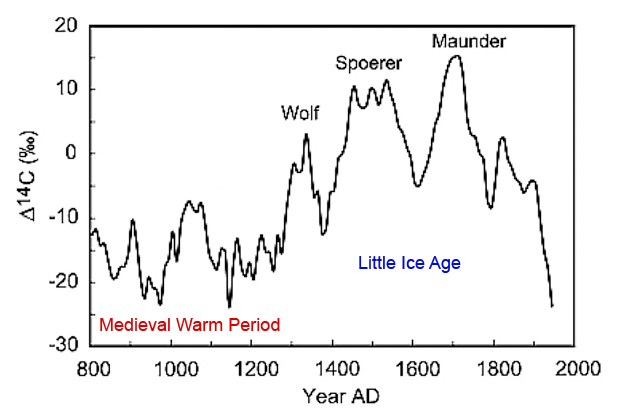Volume 11, Number 23: 4 June 2008
Eight researchers (8) hailing from China (1), Finland (1), Russia (4) and Switzerland (2) recently published a paper wherein they describe exciting new evidence that makes the case for a causative link, or set of links, between solar forcing and climate change about as iron-clad as it can get.
Working with tree-ring width data obtained from two types of juniper found in Central Asia -- Juniperus turkestanica (related to variations in summer temperature in the Tien Shan Mountains) and Sabina przewalskii (related to variations in precipitation on the Qinghai-Tibetan Plateau) -- Raspopov et al. (2008) employed band-pass filtering in the 180- to 230-year period range, wavelet transformation (Morlet basis) for the range of periods between 100 and 300 years, as well as spectral analysis, in order to compare the variability in the two tree-ring records with independent Δ14C variations representative of the approximate 210-year de Vries solar cycle over the past millennium. These analyses indicated that the approximate 200-year cyclical variations present in the palaeoclimatic reconstructions were well correlated (R2 = 0.58-0.94) with similar variations in the Δ14C data, which obviously suggests the existence of a solar-climate connection. In addition, they say "the de Vries cycle has been found to occur not only during the last millennia but also in earlier epochs, up to hundreds of millions [of] years ago."
After reviewing additional sets of published palaeoclimatic data from various parts of the world, the eight researchers satisfied themselves that the same periodicity is evident in Europe, North and South America, Asia, Tasmania, Antarctica and the Arctic, as well as "sediments in the seas and oceans," citing 20 independent research papers in support of this statement. This fact thus led them to conclude there is "a pronounced influence of solar activity on global climatic processes" related to "temperature, precipitation and atmospheric and oceanic circulation."
Complicating the matter, however, Raspopov et al. report there can sometimes be "an appreciable delay in the climate response to the solar signal," which can be as long as 150 years; and they note that regional climate responses to the de Vries cycle "can markedly differ in phase," even at distances of only hundreds of kilometers, due to "the nonlinear character of the atmosphere-ocean system response to solar forcing." Nevertheless, the many results they culled from the scientific literature, as well as their own findings, all testify to the validity of their primary conclusion, that throughout the past millennium, and stretching back in time as much as 250 million years, the de Vries cycle has been "one of the most intense solar activity periodicities that affected climatic processes."
As for the more recent historical significance of the de Vries cycle, Raspopov et al. write that "the temporal synchrony between the Maunder, Sporer, and Wolf minima and the expansion of Alpine glaciers (Haeberlie and Holzhauser, 2003) further points to a climate response to the deep solar minima." And in this regard, we would only add that earth's recent recovery from those deep solar minima could well have played a major role in the planet's emergence from the Little Ice Age, and, therefore, could well have accounted for much -- if not even the lion's share -- of 20th-century global warming, as suggested fully twenty years ago by Idso (1988).
This view of the matter is consistent with the view expressed more recently by Feynman (2007), who -- in an intriguing paper entitled "Has solar variability caused climate change that affected human culture?" -- answers this question in the affirmative, while presenting the figure we have reproduced below as supporting evidence for deep solar minima being the cause of the Little Ice Age (which doomed the Norse colonies on Greenland), and for solar maxima being responsible for the great droughts that occurred during the Medieval Warm Period (which triggered the collapse of Classical Mayan civilization in northern Central America).

Figure 1. Graph of Δ14C (higher values correspond to lower solar activity) vs. year AD. Adapted from Feynman, who attributes the relationship to Stuiver and Braziunas (1988).
Clearly, there is much to recommend the overriding concept that is suggested by the data of these several papers, i.e., that the sun rules the earth when it comes to orchestrating major changes in the planet's climate, the most recent of which changes is the climate alarmists' "unprecedented warming" of the 20th century, which they wrongly attribute to anthropogenic CO2 emissions.
Sherwood, Keith and Craig Idso
References
Feynman, J. 2007. Has solar variability caused climate change that affected human culture? Advances in Space Research 40: 1173-1180.
Haeberli, W. and Holzhauser, H. 2003. Alpine glacier mass changes during the past two millennia. PAGES News 1 (1): 13-15.
Idso, S.B. 1988. Greenhouse warming or Little Ice Age demise: A critical problem for climatology. Theoretical and Applied Climatology 39: 54-56.
Raspopov, O.M., Dergachev, V.A., Esper, J., Kozyreva, O.V., Frank, D., Ogurtsov, M., Kolstrom, T. and Shao, X. 2008. The influence of the de Vries (~200-year) solar cycle on climate variations: Results from the Central Asian Mountains and their global link. Palaeogeography, Palaeoclimatology, Palaeoecology 259: 6-16.
Stuiver, M. and Braziunas, T.F. 1988. The solar component of the atmospheric 14C record. In: Stephenson, F.R. and Wolfendale, F.R. (Eds.), Secular Solar and Geomagnetic Variations in the Last 10,000 Years. Kluwer, Dortecht, The Netherlands, p. 245.




